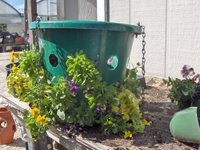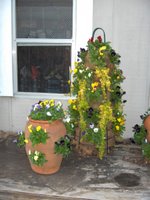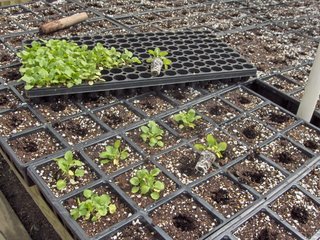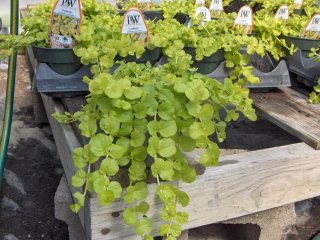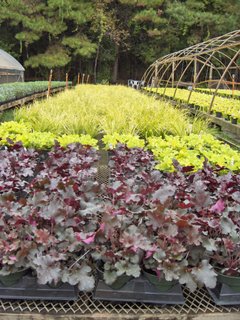Christmas is almost here and the poinsettias are in bloom. So, here are a few simple guidelines to help you care for your poinsettias at home. 
Light/Placement:
Poinsettias prefer moderately bright light but they can tolerate low light areas. In other words, you can put a poinsettia just about anywhere in the house except a bright window.
Temperature:
These plants also prefer moderately cool temperatures: 60-70 degrees during the daytime and 60-65 degrees at night are
ideal. Poinsettias can tolerate warmer and cooler temperatures
however 80 is too warm and 50 is too cold. Be sure that your plant is not directly below a vent because this will cause your flower to quickly spoil.  Watering:
Watering:
For best results, water your plant in the mornings. Be sure to water thoroughly each time and empty the excess water from the saucer when finished. Emptying excess water will help to prevent root rot. (Root rot is the #1 cause of poinsettia death in households.) Allow your plant to dry out in between watering. The soil should feel dry to the touch and the plant will feel light. In normal temperatures and moderate light this usually translates into water once every 3-4 days. Good luck!
Gardening and Landscaping by PRWeb
Monday, November 27, 2006
Poinsettia Care
Posted by
The Plant Pixie
at
8:57 PM
![]()
Wednesday, November 22, 2006
Caring for Christmas Cacti

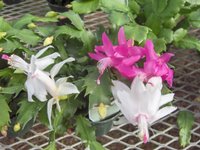 They favor temperatures between 65 - 85 degrees but can tolerate temperatures as low as 35 with minimal leaf damage. This variety of cactus enjoys a well lit area such as a sun room or kitchen window but not the bright, direct afternoon sun. Feed your Christmas cactus plant once every three months with a balanced fertilizer (10-10-10) for best results. This cactus plant, like poinsettias, knows when to bloom by measuring day length. Be sure to avoid electric lighting during September and October to ensure that your Cactus will bloom.
They favor temperatures between 65 - 85 degrees but can tolerate temperatures as low as 35 with minimal leaf damage. This variety of cactus enjoys a well lit area such as a sun room or kitchen window but not the bright, direct afternoon sun. Feed your Christmas cactus plant once every three months with a balanced fertilizer (10-10-10) for best results. This cactus plant, like poinsettias, knows when to bloom by measuring day length. Be sure to avoid electric lighting during September and October to ensure that your Cactus will bloom.
Posted by
The Plant Pixie
at
10:12 PM
![]()
Sunday, November 19, 2006
Container Gardening
 I think this is partially because homes are being built on smaller and smaller plots of land and partially because more and more homes have 2 income families who have less time to putter around the garden. Whatever the reason, container flower gardening can be a fun, easy way to brighten up your yard with some color. There is a huge variety of pots, baskets, window boxes, etcetera out there. From the most simplistic green plastic pot to the truly eccentric and grand. I know that I have seen just about every shape and size pot imaginable for sale. There are even hanging baskets with built in side holes to plant more flowers (like a strawberry pot). Whatever your tastes, there is something perfect for you out there! Here is a smattering of pictures of container gardens, window boxes, and baskets that I have seen this fall. Click on the picture to see a larger view!
I think this is partially because homes are being built on smaller and smaller plots of land and partially because more and more homes have 2 income families who have less time to putter around the garden. Whatever the reason, container flower gardening can be a fun, easy way to brighten up your yard with some color. There is a huge variety of pots, baskets, window boxes, etcetera out there. From the most simplistic green plastic pot to the truly eccentric and grand. I know that I have seen just about every shape and size pot imaginable for sale. There are even hanging baskets with built in side holes to plant more flowers (like a strawberry pot). Whatever your tastes, there is something perfect for you out there! Here is a smattering of pictures of container gardens, window boxes, and baskets that I have seen this fall. Click on the picture to see a larger view!


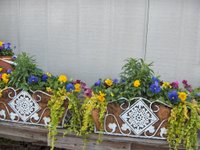
Posted by
The Plant Pixie
at
8:01 PM
![]()
Monday, October 16, 2006
How to recognize Poinsettia Colors...
Poinsettia Colors
Have you ever wondered how a professional gardener can tell what color a non-blooming poinsettia is? How do we just glance at a plant and say, with confidence, that plant is purple, pink, red, or white?
It's a simple trick that any one can learn. Simply look at the stem of the leaves. They will always be the same shade that the poinsettia is going to turn into. If you are intimately familiar with poinsettias the leaves will also be a hint. For example, Prestige Red has different foliage than Red Velvet. However, for distinguishing the difference between main colors, all you need to do is look at the stem of the leaf.
Some examples are illustrated below:
Prestige Red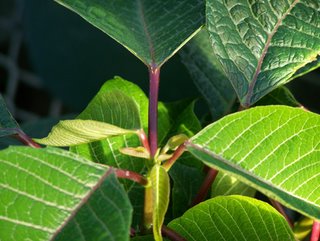
Cortez Burgundy (a plum colored poinsettia)
Snowcap (White)
Enduring Pink
I am not, however recommending the purchase of a poinsettia that has not already started to turn shades. Getting a poinsettia to bloom at home can be tough. They need a certain amount of dark (12 hrs. usually) and even street lights or car lights can play havoc with the plant's need for darkness. On the other hand, if you like to experiment or are an 'old-hat' at raising poinsettias, this tip is an easy insurance that you're buying the correct color.
Posted by
The Plant Pixie
at
10:20 PM
![]()
Thursday, October 12, 2006
Pansy and Viola Flower Gardening

Planting Your Pansies and Violas
If you buy your pansies from a reputable grower pansy care is very easy. Some people prefer to mix bonemeal, bloodmeal, or manure in their flower beds. This is because pansies love nitrogen and iron. Bonemeal and bloodmeal are both nitrogen rich, organic fertilizers. I prefer bonemeal because it slowly releases the nitrogen into your flower bed and is also a good source of organic phosphates. You can still grow beautiful pansies without this step but if you have the energy and time, go ahead. Your plants will thank you.
Ok, our beds are tilled and ready. It's time to plant. If the plants you are planting are root-bound rough up the bottom of the root ball before planting. (Firmly rub your thumb along the bottom of the root ball to break up a few of the roots.) This will help to stimulate growth in the plant. Now dig a hole and plant! The top of the root ball should be flush (level) with the top of your flower bed. Do not plant pansies deep. They will suffocate and die. Lastly, water in your freshly planted bed(s). It doesn't matter if your plants were wet or dry. The goal here is to let the excess loose soil sink into any remaining air pockets around the root system of the plants.
Maintaining your winter garden
Pansies need food and care, like any other living thing. Here you have some choices. Do you like feeding your garden by hand every few weeks or are you a low-maintenance type gardener? If you are one of those who likes to putter in the garden find a good liquid fertilizer that you can apply every two or three weeks. Pansies will accept most basic fertilizers but for a guideline: 15-2-20 is the fertilizer I find works best. The basic 10-10-10 will do in a pinch. If you have granular ironite be sure to sprinkle some around the beds every 3-4 months.
Now, for those of us who prefer low maintenance flower beds, time release fertilizer is the answer. My two favorites are Electra and Florikan. Just sprinkle liberally around the flower bed (on the dirt - not on top of the plants themselves) and allow the rain and/or sprinkler system to do the work for you. Electra should be applied once every couple of months for a fantastic show of color. I'm afraid Florikan is not yet available in the retail market but your local nursery has probably already applied it to their pansy stock.
Lastly, but not least important, for best results you should deadhead your garden once or twice every month. This will keep your plants blooming at their maximum and prevent them from going to seed.
These are the same principals that any professional grower will follow when growing their own pansies/violas for sale. Here are some pictures from the three main stages of my past (2006) growing season for retail sale.
Planting Pansies (Note that these pansy plugs are slightly root-bound and we do rough up the bottoms before planting)
Growing Baby Pansies (2 weeks after planting)
Ready to sell! (2 months later)
Posted by
The Plant Pixie
at
4:19 PM
![]()
Thursday, October 05, 2006
Winter Accent Plants
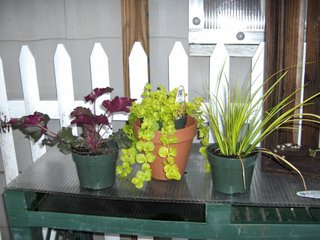
Winter flowers in the southeastern US have traditionally been pansies but in the past few years some exciting new-comers have entered the market. "Proven Winners" has come out with a series called 'Fall Magic' that has some true winners in it. I have been experimenting with these in my own yard for a few years and have a few favorites of my own. My top 4 from this series are Goldilocks, Lavender Cotton, Purple Petticoats and Ogon Grass. Each of these adds a little something different to you containers and/or garden.
A growing new trend is the use of winter snapdragons. These plants usually grow to about 2 feet and bloom in the late fall (Oct-Nov). Snapdragons come in all shades of pink, yellow, white, lavender, and red. Once the flowers die the plant will stay green through the worst of our winter months and began to bloom again in the early spring (late Feb-March). My favorite variety is 'Liberty' which seems to stand up to rust better than some other varieties.
Another choice is the Ornamental Cabbage or Ornamental Kale. These plants come in pink, white and red. While they grow to the same height and width as the edible variety, these are decorative only! The cooler the weather, the more vibrant their colors will become. Cabbage and kale plants not only have a great foliage to add texture but they, like the snapdragon and lavender cotton, will bloom in the spring.
These are, by no means, all of your options for a winter garden. Next time you're shopping for pansies at your local garden center, pause a moment and look around. You might be surprised at all the options available to you!
Posted by
The Plant Pixie
at
8:10 PM
![]()
Sunday, October 01, 2006
An oft overlooked treat
Lavender Cotton (Santolina Chamaecyparissus)
I believe that lavender cotton is an often overlooked and unappreciated plant in our region. This particular plant is usually found in our nurseries in the fall/winter season. However, it is evergreen and just as beautiful in the spring and summer months. The foliage has a greenish - grey tint similar to that of a dusty miller and soft fuzzy leaves . The average plant will only reach about a foot in height but will sprawl out 2-3 feet in length when planted in the ground.
Posted by
The Plant Pixie
at
6:45 PM
![]()
Saturday, September 30, 2006
Pansies vs Violas
What is the difference between pansies and violas?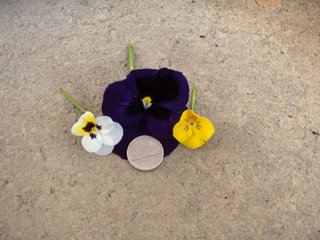 This is a question that I hear quite frequently this time of year. Violas (sometimes called Johnny Jump Ups) are simply a miniature version of pansy. Pansy flowers typically are about the size of a silver dollar. Viola flowers , however, range between the size of a nickel and a quarter. Both plants grow to the same basic height and width in the foliage. Violas, though, tend to have 3 - 4 times more flowers per plant at any given moment. So, while their individual flowers are less than half the size of a pansy, for color and show the two plants are fairly equivalent. They both also have the same food and care requirements. If you can grow one the other will be no problem. One big difference between the two plants is that violas tend to be more shade tolerant than pansies.
This is a question that I hear quite frequently this time of year. Violas (sometimes called Johnny Jump Ups) are simply a miniature version of pansy. Pansy flowers typically are about the size of a silver dollar. Viola flowers , however, range between the size of a nickel and a quarter. Both plants grow to the same basic height and width in the foliage. Violas, though, tend to have 3 - 4 times more flowers per plant at any given moment. So, while their individual flowers are less than half the size of a pansy, for color and show the two plants are fairly equivalent. They both also have the same food and care requirements. If you can grow one the other will be no problem. One big difference between the two plants is that violas tend to be more shade tolerant than pansies. 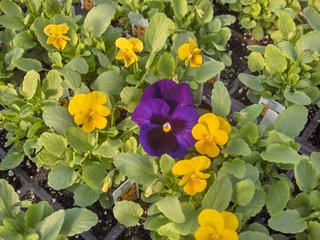 Both plants love full sun but violas will still bloom in shadier areas, where as your average pansy will not. Many people choose one or the other in their flower beds but mixing them in the same bed makes a beautiful show. Use pansies in the center of your flower beds and use the violas as an edger (outline along your bed). Then stand back and enjoy the compliments!
Both plants love full sun but violas will still bloom in shadier areas, where as your average pansy will not. Many people choose one or the other in their flower beds but mixing them in the same bed makes a beautiful show. Use pansies in the center of your flower beds and use the violas as an edger (outline along your bed). Then stand back and enjoy the compliments!
Posted by
The Plant Pixie
at
4:03 PM
![]()
Fall Has Arrived!

It's pansy season people! I just love pansies and violas. Pansies are one of the few plants I have encountered that come in any and every color imaginable. Not only do pansy flowers come in every color of the rainbow but they are also available in any mix of colors at your local nursery. You want an orange and purple flower? Red and yellow, perhaps? No Problem!
Not only do pansies come in a beautiful array of colors but they are also one durable little plant here on the southeast coast. When properly cared for your pansies will last from October up until May of the following year. That is 7-8 months of continuous color from one little plant! That is a great investment for anyone's garden. The only weather pansies can't tolerate is our hot, hot summer months. (And really, who can blame them!) During the winter, however, pansies can stand up to the worst mother nature has to offer. Neither icy rain nor snow will harm them. So the next time someone calls you a pansy take it as a complement!
Posted by
The Plant Pixie
at
12:34 PM
![]()
Tuesday, September 26, 2006
Flowers and Fashion
Okay, I admit it. When I first started working in a nursery I was a neophyte. I knew next to nothing about flowers. My boss told me that pointsettias don't really flower but the leaves change color. I thought he was just teasing me! I had spent months anxiously awaiting flower buds. Well, live and learn.
However, lately I have noticed that the flower industry is a lot like the fashion industry. There is always a new it plant that everyone and their neighbor has either seen on TV or in a magazine and just must have for their own garden. Often times regardless to how acceptable their garden environment is to said plant.
My choice it plant this year is Tacoma Stans (a.k.a. Yellow Bells). 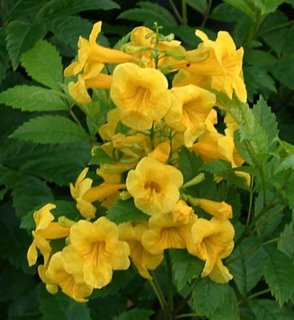 This plant is durable, forgiving and hardy. Yellow bells is fairly wind resistant and doesn't mind poor sandy soil. It is drought tolerant and can survive our brutal summer months. It also has the cutest cheerful yellow flowers all along the stalks. These flowers smell just like cotton candy. (No, really they do!) The plant can grow several feet tall but will also drape down beautifully in a hanging basket. All in all, Yellow Bells is one of the best new plants I have tried this year and I have thoroughly enjoyed them in my garden this summer.
This plant is durable, forgiving and hardy. Yellow bells is fairly wind resistant and doesn't mind poor sandy soil. It is drought tolerant and can survive our brutal summer months. It also has the cutest cheerful yellow flowers all along the stalks. These flowers smell just like cotton candy. (No, really they do!) The plant can grow several feet tall but will also drape down beautifully in a hanging basket. All in all, Yellow Bells is one of the best new plants I have tried this year and I have thoroughly enjoyed them in my garden this summer.
Posted by
The Plant Pixie
at
10:06 PM
![]()
Fun Plant Names
Have you ever wondered who assigns names to plants? 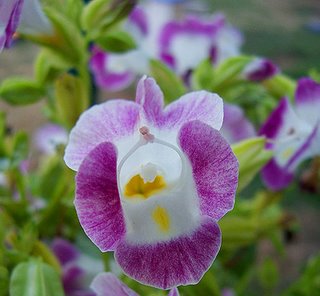 Most plants have scientific names that even a Latin enthusiast would stumble over. Fortunately for us common folk, most plants have 'common' names that are much easier to remember. Some of these are really quite clever.
Most plants have scientific names that even a Latin enthusiast would stumble over. Fortunately for us common folk, most plants have 'common' names that are much easier to remember. Some of these are really quite clever.
One of my favorites is the Wishbone plant (a.k.a. Torenia Fournieri). The stamen inside the flower literally look like a miniature wishbone. This common name is both descriptive and easy to remember. Once you see the visual image, one is unlikely to forget it's name. Where as the name Torenia might easily slip your mind when you are shopping around next season.
Another plant with an amusing name is the Snapdragon (a.k.a. Antirrhinum majus) . Try viewing the flowers from the side instead of from above. With a little bit of imagination one can see the flower as the head of a traditional dragon, crest and all. The "mouth" of the flower will even pop open and snap shut with slight pressure on the base of the flower. This is an especially amusing treat when walking through the garden with children.
My third entertaining 'common' name for the day is the lovely little balloon flower(a.k.a. Platycodon grandiflorus). When this 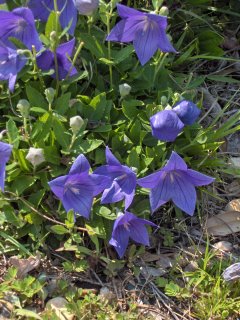 plant is tightly budded it looks very much like a bunch of little pink, white, or blue balloons floating above the plant. If one gently squeezes the flower you can feel the air pressure inside. Warning! Squeeze too tightly and the bud will 'explode' prematurely and die. The balloon flower will pop open in it's own time to become a beautiful flower.
plant is tightly budded it looks very much like a bunch of little pink, white, or blue balloons floating above the plant. If one gently squeezes the flower you can feel the air pressure inside. Warning! Squeeze too tightly and the bud will 'explode' prematurely and die. The balloon flower will pop open in it's own time to become a beautiful flower.
These three names are my top favorites of all the common names of flowers that I have encountered. I think each of them are descriptive and easy to remember. Heard any good ones yourself?
Posted by
The Plant Pixie
at
7:48 PM
![]()
Gardening & Horticulture Info Coming Soon!
Please bear with us as we get this blog site together... :)
Thanks for your patience!
Posted by
The Plant Pixie
at
1:45 PM
![]()







